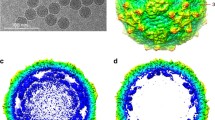Summary
The properties of three strains of VEV have been examined in an attempt to define its place in the classification of animal viruses. Each strain grew to high titre in a pig kidney cell line, IB-RS-2, was resistant to lipid solvents and pH 5 and could be purified by precipitation with ammonium sulphate, differential ultracentrifugation, detergent treatment and sedimentation in a sucrose gradient. The purified viruses had sedimentation coefficients in sucrose gradients of 160–170S and densities in caesium chloride ranging from 1.370 to 1.377 g/ml. In the electron microscope the 35–40 mμ particles had an appearance very similar to that described for the feline picornaviruses. Infectious RNA was obtained from each of the strains by extraction with 1% sodium deoxycholate and phenol. The infectivity of the RNA was destroyed by trace amounts of ribonuclease, indicating that the RNA is single-stranded. Labelled RNA prepared from32P-virus sedimented in a sucrose gradient at 35–38S and was disrupted into slowly sedimenting molecules by incubating with 0.01 μg ribonuclease per ml prior to centrifugation. The percentage distribution of32P in the four nucleotides was adenylic acid 29.0: cytidylic acid 25.1; guanylic acid 20.6; uridylic acid 25.3.
Similar content being viewed by others
References
Almeida, J. D., A. P. Waterson, J. Prydie, andE. W. L. Fletcher: The structure of a feline picornavirus with a relevance to cubic viruses in general. Arch. ges. Virusforsch.25, 105 (1968).
Bachrach, H. L.: The determination of the sedimentation constant of a homogeneous component having the characteristics of the foot-and-mouth disease virus. Amer. J. vet. Res.13, 13 (1952).
Brown, F., andB. Cartwright: Purification of radioactive foot-and-mouth disease virus. Nature (Lond.)199, 1168 (1963).
Brown, F., andJ. F. E. Newman:In vitro measurement of the potency of inactivated foot-and-mouth disease virus vaccines. J. Hyg. (Lond.)61, 345 (1963).
Bürki, F.: Picornaviruses of cats. Arch. ges. Virusforsch.15, 692 (1965).
Campbell, C. H.: Relationship of donor age toin vitro production of foot-and-mouth disease virus by mouse kidney cells. J. exp. Med.121, 69 (1965).
de Castro, M. P.: Comportamento do virus aftoso em cultura de células: susceptibilidade da linhagem de células suinas IB-RS-2. Arch. Inst. biol. (S. Paulo)31, 63 (1964).
Madin, S. H., andJ. Traum: Vesicular exanthema of swine. Bact. Rev.19, 6 (1955).
Martin, R. G., andB. N. Ames: A method for determining the sedimentation behaviour of enzymes: application to protein mixtures. J. biol. Chem.236, 1372 (1961).
Oglesby, A. S.: Biochemical and biophysical characteristics of vesicular exanthema of swine virus. Ph. D. Dissertation, Univ. of California (1965).
Randrup, A.: Ultracentrifugation of the virus of foot-and-mouth disease. 1. Experiments for the determination of the sedimentation constant of the virus. Acta path. microbiol. scand.31, 385 (1952).
Shoemaker, A. C., F. L. Schaffer, andS. H. Madin: Purification and properties of vesicular exanthema of swine virus. Bact. Proc.16, 130 (1963).
Simpson, R. W., andR. E. Hauser: Structures associated with influenza virus suspensions treated with phospholipase C. Virology27, 642 (1965).
Simpson, R. W., andR. E. Hauser: Structural components of vesicular stomatitis virus. Virology29, 654 (1966).
Zee, Y. C., andA. J. Hackett: The influence of cations on the thermal inactivation of vesicular exanthema of swine virus. Arch. ges. Virusforsch.20, 473 (1967).
Zee, Y. C., A. J. Hackett, andL. T. Talens: Electron microscopic studies on the vesicular exanthema of swine virus. 2. Morphogenesis of VESV Type H54 in pig kidney cells. Virology34, 596 (1968).
Zwillenberg, L. O., andF. Bürki: On the capsid structure of some small feline and bovine RNA viruses. Arch. ges. Virusforsch.19, 373 (1966).
Author information
Authors and Affiliations
Additional information
British Council Scholar on leave of absence from the Microbiology Department, School of Agriculture, The University, Lublin, Poland.
Rights and permissions
About this article
Cite this article
Wawrzkiewicz, J., Smale, C.J. & Brown, F. Biochemical and biophysical characteristics of vesicular exanthema virus and the viral ribonucleic acid. Archiv f Virusforschung 25, 337–351 (1968). https://doi.org/10.1007/BF01556562
Received:
Issue Date:
DOI: https://doi.org/10.1007/BF01556562




